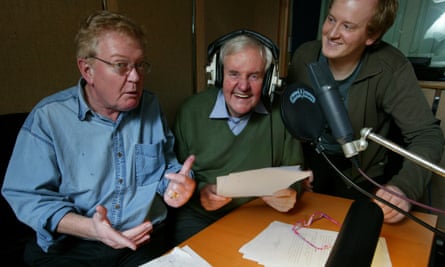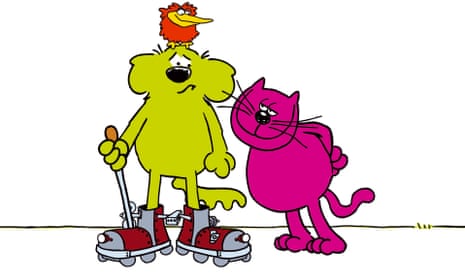Grange Calveley, who has died after suffering a stroke aged 78, was the creator and writer of Roobarb, the visually groundbreaking, popular cartoon series screened on British television in the early 1970s, during a golden age of children’s animation. His inspiration came when he and his wife, Hanny, moved into a new Hertfordshire home and bought a Welsh border collie. “We came to live in this lovely house with its big garden, its shed and its old conker tree,” he recalled. “Oh, and the rhubarb that grew under an old rusty bucket. That’s about when our four-legged Welsh friend moved in and the first thing he did was to water the rhubarb. And, from that moment on, we called him Roobarb.”
Calveley started drawing sketches of a dog’s adventures and kept knocking on the door of the BBC, imploring it to take up his idea, which also featured a cat called Custard, based on his neighbours’ pet. The pre-school children’s show Play School considered his stories too short for its 15-minute slot, but Calveley was persistent and finally able to sell his idea when the Australian-born director Bob Godfrey – who had already made a cartoon series featuring the Beatles and mock-erotic short films such as Kama Sutra Rides Again – suggested producing a 30-second black-and-white sample.

Photograph: Sean Smith/The Guardian
The result, which they made with another Australian, the animator Peter Green, and which eventually became the basis of the title sequence, impressed the BBC’s head of children’s programmes, Monica Sims, who commissioned a pilot. The five-minute story, When Roobarb Made a Spike, with the dog recreating a bird’s beak in order to extract worms from the garden, was enthusiastically received when it was screened in 1973 at film festivals in France and Italy, and as one of the year’s outstanding short films at the National Film Theatre, London.
It began the 30-episode series screened the following year, which was written by Calveley – who also provided 30 key drawings per episode from which the animators worked – while Godfrey and Green brought the stories to life.
Roobarb, sold to more than 40 countries, was the first animated British TV series to be drawn and coloured entirely with felt-tip pens. Its distinctive bouncy, wobbly feel came out of the lack of budget for traditional celluloid and painting techniques, instead employing white paper and the felt markers that Calveley brought from the office of the advertising agency for which he worked. This resulted in fuzzy lines and irregular, streaky colours. The overall effect was enhanced by Johnny Hawksworth’s bouncy music and Richard Briers’s distinctive narration. Calveley depicted the green Roobarb, a dog with a thirst for adventure, as slightly pompous, brought down to earth by the pink cat, Custard.
Together, Calveley and Godfrey then made 30 episodes of Noah and Nelly in … SkylArk (1976), stories loosely based on Noah’s Ark with Briers narrating, but featuring just one of each animal – with two heads. This time, Captain Nutty Noah’s ambitious sea, land and air voyages in his double-headed vessel were saved by his wife Nelly’s knitting skills when they went wrong.
At the turn of the century, more than 20 years after moving to Australia, Calveley launched a website nostalgically recalling Roobarb. It led to demand for new episodes, which he satisfied by writing a 2005 series, Roobarb & Custard Too, screened by Channel 5 in Britain. Although faithful to the original, with white backgrounds, the “wobbly” look and Briers narrating, the 39 episodes introduced new animal characters and were produced with computer animation.
Grange was born in Hale, Cheshire, to Alice (nee Williams) and Sam Calveley, a soldier turned police officer. In 1944, when he was a baby, his father died in Italy during second world war action as a captain with the King’s regiment.
Aged 15, he left Bradbury secondary modern school in Cheshire, where he was head boy, to join Osborne Peacock, a Manchester advertising agency, which sent him on day release to art college. He then spent a year with a Stockholm agency writing promotional campaigns for Saab fighter jets and milk and cheese products. On moving to London, Calveley worked for Masius Wynne-Williams (1966-73) as writer and art director of national campaigns for everything from jam, marmalade and coffee to toys, fridges, trucks and bras.
In 1977, Calveley moved to Sydney, working for the TCN-9 channel on children’s programmes such as Super Flying Fun Show (until 1979), then ABC, for which he devised a new animated series, Captain Cookaburra’s Road to Discovery (1985-86), written with Hanny, who was a copywriter at Masius Wynne-Williams.
More recently, he wrote and illustrated the Adventures of Porridge Oats series of books (2018), featuring a white dog with coloured spots, and drew cartoon characters for the Sniffe & Likkit dog grooming range.
Hanny (nee Hania Sitkowska), whom he married in 1969, died of cancer in 2011. Calveley is survived by their children, Spencer and Piers, and his brother, David.

Comments (…)
Sign in or create your Guardian account to join the discussion